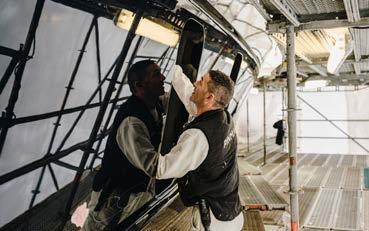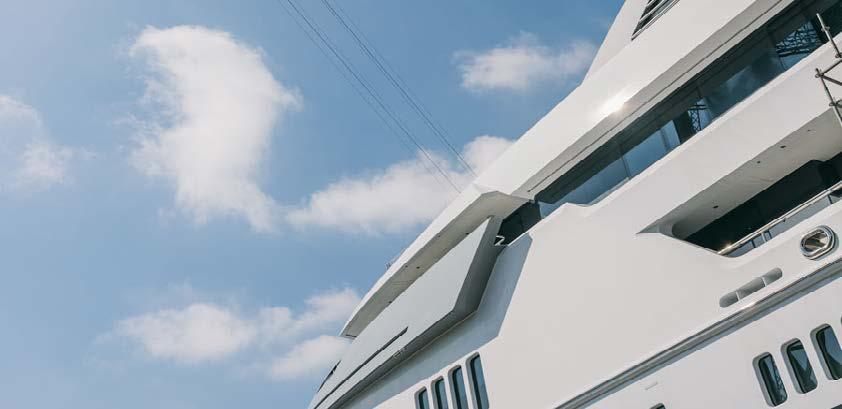
3 minute read
Air
/ Index / Foreword / Our commitment / Carbon footprint / Air / Waste / Water / Community / People / Financial & governance
Our commitment
Advertisement
To work with all our stakeholders to improve air quality.
This includes implementing strict working methods that result in the use of best practices, improvements in infrastructure and the prioritisation of innovative sustainable solutions.
/ Index / Foreword / Our commitment / Carbon footprint / Air / Waste / Water / Community / People / Financial & governance
Context
One of our key objectives, developed to fight against pollution, focuses on the minimisation of combustible gas emissions and Volatile Organic Compounds (VOCs) produced in the facilities.
In line with the standards on VOC emissions, activities related to surface treatment-filling, priming and painting are the ones that use the largest quantity of solvents.
VOCs are volatile at room temperature and are emitted as soon as a paint or solvent canister is opened. Solvents are used to dilute paint and facilitate the application of paint or coatings. Once the primer or paint has been applied, the solvents evaporate into the air while the paint is drying. By use of a tent with a mechanical exhaust ventilation, the exhaust discharge is then channelled through filters to trap pollutants. In the case of large painting works, gas washing equipment (also called “scrubbers”) is used complying with MB92 emissions limits. Extraction boxes with a carbon activated filtration stage are used for small painting works.
Our investigation into technical solutions to further reduce VOCs continues, either through methods that improve transfer efficiency (percentage of the product coated on the surface), such as electrostatic automation, or through new technologies for waste treatment.
Scope 1
Gasoil - litres (Barcelona)*
Gasoil- litres (La Ciotat)**
Scope 2
Electricity kWh (Barcelona)***
Electricity kWh (La Ciotat)****
Total (Tonnes CO2eq)
The consolidated measurement of the emissions of Greenhouse Gases (GHG) in the Group in 2021. This has been calculated by non-exhaustive estimates of the most relevant aspects associated with these emissions.
Consumption (2021) Emissions Tn (2021)
378,924
1,854.51 1,854.51
592.78
467,098 1,476.02
22,769,941
10,515,725
2,467.58 2,467.58
Source for 2021 Emissions
(*) Source of 2021’s emissions, Barcelona: 2.79 (Kg eq.CO2/l). Source: Informe inventarios GEI 1990-2011 (2013) [GHG Inventory Report 1990-2011 (2013)]. Guía práctica de gases de efecto invernadero versión 2014. [Greenhouse gases practical guidelines version 2014]
(**) Source of 2021’s emission, La Ciotat: 3.16 (Kg eq.CO2/l) Source: ADEME (L’Agence de l’environnement et de la maîtrise de l’énergie)
(***) The electric power consumption at MB92 Barcelona’s main office during the year 2021 has been fully supplied by renewable energy.
(****) Source of 2021’s emission, La Ciotat: 0.0583 (t eq.CO2/kWh). Source: ADEME (L’Agence de l’environnement et de la maîtrise de l’énergie). It should be noted that this calculation of the carbon emissions has not considered the negative emissions resulting from the self-consumption of the photovoltaic plates.
/ Index / Foreword / Our commitment / Carbon footprint / Air / Waste / Water / Community / People / Financial & governance
Actions completed
Actions in progress

Emissions control pursuant to the latest legal requirements.
Use of market-leading air filtration and supervision systems to improve air quality in and around working facilities. Environmental vigilance to verify
the implementation of good
practice to avoid VOC (Volatile Organic Compounds), particle and GHG (Green House Gas) emissions. Application of electrostatic coating
to reduce the amount of coating
applied per surface unit by 30-40%.
Real-time supervision of the level of VOCs and other parameters inside paint tents using sensors and monitoring software.
Ionisation system for wastewater from scrubbers. Use and promotion of sustainable alternatives to conventional
antifouling.

Future actions
Ozone injection during gas washing
to reach better VOC reduction levels.
Identification of new technology to

